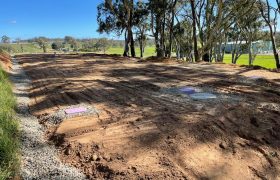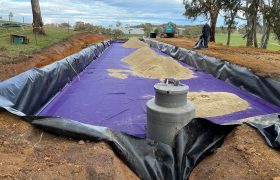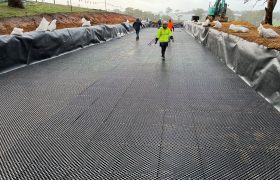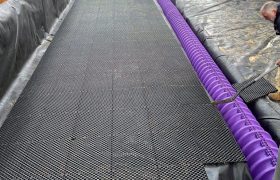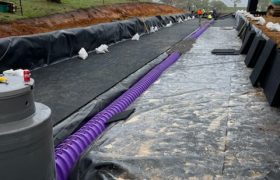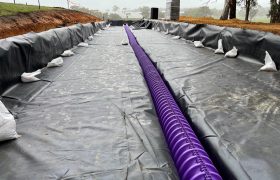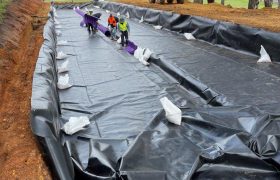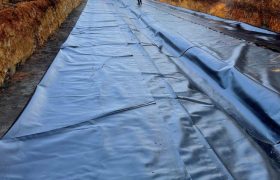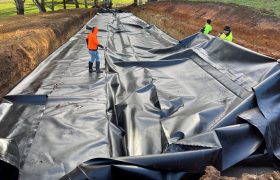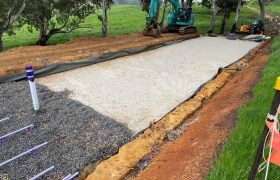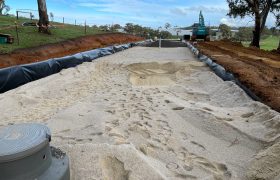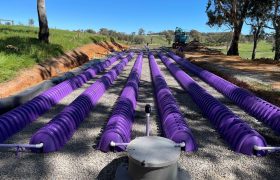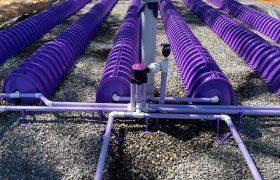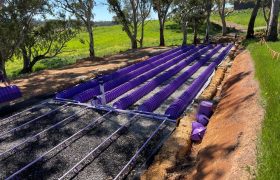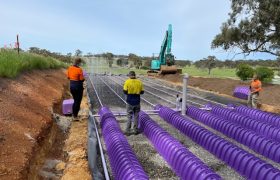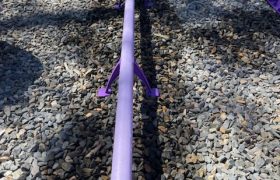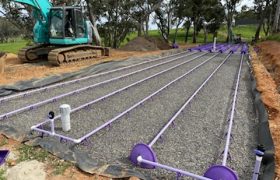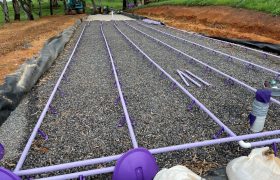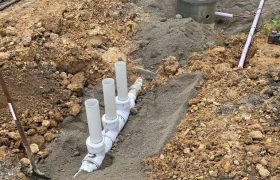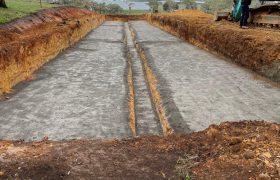Lot 100 Winery – wastewater treatment
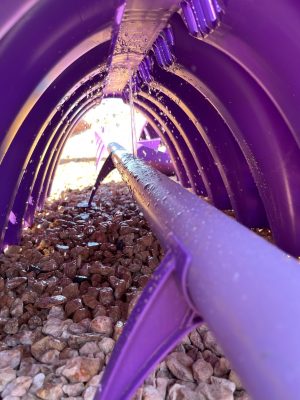
Lot 100 Winery is a licenced function venue with a collective of local food and craft beverage producers, located at 68 Chambers Road, Hay Valley, South Australia. This project required an on‑site wastewater treatment and recycled water disposal system to meet the venues increasing demand.
Lot 100 Winery is also a special events venue for weddings, catering up to 500 attendees. The site emphasises its commitment to environmental sustainability and requires a treatment & reuse system which was passive and/or low-impact and minimal carbon emissions from its operation.
Arris consulted with the client to investigate the existing wastewater treatment system and prevailing site conditions. Arris designed an environmentally & economically sustainable low-input wastewater treatment and recycled water dispersal system which was fit-for-purpose for the site. We incorporated the existing tanks from the previous wastewater treatment system and reused as much of the existing infrastructure as possible within the design. The tanks were adapted to provide passive treatment. An additional tank was installed to manage the increased design flow. The primary treatment system has been configured to mitigate the adverse impacts of variable wastewater generation patterns. Arris obtained the required approvals from the relevant Regulators.
We installed and commissioned the new treatment & reuse system. Arris provides ongoing maintenance to this installation. This has been a very successful design, build, operate & maintain project, maximising site environmental assets and minimising installation costs.
Site assessment
- Sources of wastewater:
- Staff amenity wastewater
- Function centre wastewater
- The peak daily flow has been calculated to be 12,000L/d, peak visits 600p/d at 20L/p/d from the site assessment
- Wastewater treatment system and recycled water reuse method needs to be capable of managing variable flows
- The client desired to reuse as much of the existing wastewater treatment infrastructure as possible
- Regulatory approval needed to gained for the new wastewater treatment system and dispersal method
Land capability assessment
The purpose of the LCA is to:
- Assess the capability of land to sustainably utilise and manage wastewater within the boundary of the property
- Determine high risk and sensitive areas and outline measures for the mitigation of those risks
- Gather the relevant geographical information to adequately inform the process of designing the best practicable and most sustainable onsite wastewater treatment and effluent recycling / dispersal system to minimise the health and environmental impacts of onsite wastewater management
- Determine the Design Loading Rate, in accordance with AS/NZS 1547:2012
- Provide the basis for Regulatory Approval
Based on the particle size analysis, the soil type and the infiltration test, a DLR of 12mm/m2/d is used for secondary treated wastewater.
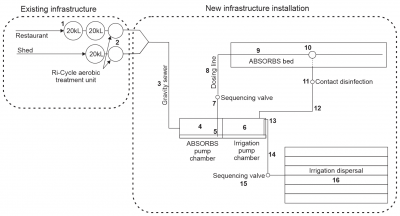
Schematic of treatment process and irrigation/reuse system
Component description
1) New 20kL primary treatment tank to augment treatment capacity
2) Decommissioning of the aeration systems to convert to primary treatment
3) 100mm DWV gravity sewer
4) 8kL pump chamber for pressure dosing ABSORBS bed, will be configured as 7kL emergency storage and 1kL pump chamber
5) 2 x 1.1KW Pedrollo pump DM 30-N with float and timed pump controller for sequential dosing
6) 8kL pump chamber for irrigation will be configured as 6kL emergency storage and 2kL pump chamber
7) 6 port K-Rain sequencing valve
8) 40mm pressure pump line
9) 400m² ABSORBS bed (4 x 100m x 6 zones) dosed intermittently
10) Inspection manhole
11) Chlorine contact disinfection
12) 100mm DWV gravity sewer
13) 2 x Lowara 10HM05NM irrigation pumps
14) 63mm PN12 poly irrigation main
15) 4 port K-Rain sequencing valve
16) 3,000m² surface irrigation DLR 4mm (4 zones @ 800m²)
ABSORBS™ beds
- An advanced secondary system and proprietary version of a single pass sand filter (SPSF) which includes sequential intermittent timed dosing
- Is certified to produce a consistently very high-quality effluent (advanced secondary level with ≥90% of effluent samples <10 mg/L for BOD5 and TSS and <10 NTU turbidity)
- System achieves near-complete nitrification of effluent (97% ammonia removal) as well as 29% median nitrogen removal and 35% median phosphorus removal
- Installation of drainage cells
- Installation of drainage cells
- Installation of drainage cells
- Beds sides and bottom are lined with 1mm HDPE liner
- Installation of poly tunnel
- Installation of poly tunnel and pipework
- Installation of poly tunnel
- Installation of distribution pipes over 20-40mm screened gravel
- Beds excavation
Advantages of the ABSORBS™ solution
- Reliable, works well in highly fluctuating conditions (in flow volume and water quality)
- Can combine both treatment and disposal within the same infrastructure. The ABSORBSTM beds can be constructed to treat and retain the water (Lot 100 case) or treat and dispose of the water under the same envelope as a bottomless version saving on disinfection, storage and transfer costs as well as reducing the required land area for management
- Very low Operation & Maintenance (O&M) requirements as there are only two mechanical components:
- Sequencing valves, the ABSORBSTM system uses passive sequencing from the pressure and flow from the dosing pump-line to intermittently dose the filters
- Dosing pumps & pump controller, as the ABSORBSTM system intermittently dose the filter beds the pumps typically run for less than two hours per day pumping clarified effluent, which means very low wear and tear
- The sequencing valves, pumps and pump controller allow for intermittent dosing across the bed.
- This type of dosing is considered to be World’s Best Practice
- Minimises the risk of leaching or surface pooling
- Allows the bed to go through wetting and drying cycles
- Allows for different aeration conditions across the bed to maximise treatment efficiency
- It is an energy efficient application method
- Works well with sites with variable flows
- This type of low-input wastewater treatment system has a relatively small carbon footprint. For example, energy is not required to power aerators 24/7
- This also lowers the operational cost of the system
- Robust – Very few moving parts reducing risk of any mechanical failure.
- Minimises the maintenance required for the system

